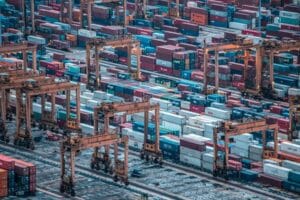Essential cargo handling equipment: How ports keep global trade moving

Photo by Ammiel J Wan on Unsplash
Shipping containers are indispensable when it comes to moving products across seas, on trains, or by roads. The smooth flow of trade relies on the secure, efficient, and reliable management of these containers. A vital part of this operation is shipping container handling equipment, which facilitates the storage, transfer, and administration of containers at distribution centres, warehouses, and ports.
Here are the various cargo handling systems and equipment used by ports and how they contribute to increased efficiency and production.
Container cranes
When it comes to port container handling systems, container cranes are the backbone that keeps things running smoothly and quickly. They facilitate the loading and unloading of cargo containers from ships. Their long booms extend on top of the ship, and are controlled from a cabin next to a trolley. Using twist locks, the operator secures the spreader to the container, allowing for precise positioning. These cranes enable both horizontal and vertical movement of containers between the shore and the ship. Additionally, being rail-mounted, they can move along the ship docking area, aligning parallel to the ships they serve.
Straddle carriers
Straddle carriers are used to transport containers across the dock efficiently. The operator is positioned above the container, facing perpendicular to the direction the straddle tractor moves, providing a clear view for precise handling. A spreader is secured to the container’s lid using twist locks. To make the most of storage space, straddles can drive over existing stacks and rack up to three containers on top of each other. Additionally, they can be used to load trucks underneath them due to their height clearance and construction design.
Terminal tractors
Terminal tractors are primarily used for short-distance transportation of containers such as within a port, cargo yards, warehouses, or intermodal facilities. These versatile semi-tractors streamline the process of loading and unloading trailers. With their smaller wheelbase and tighter turning radius, these trucks can manoeuvre more easily through yards compared to conventional heavy-duty trucks.
Container handlers
There are two main types of container handlers: empty container and loaded container handlers. Empty container/side handlers are used for moving and stacking containers that are empty in ports and yards. They pick up containers by their longest sides and move them around with the help of an attachment and a long, telescopic vertical arm.
Due to their limited lifting capability of about 10 tons, empty container handlers are not suited for hauling full/loaded containers. Despite being unable to carry as much, they can rack and raise huge containers to amazing heights. On the other hand, loaded container/top handlers can lift roughly 45 tons, which is much more than empty container handlers; however, they are limited in how high they can stack containers.
Conclusion
The efficient functioning of worldwide supply networks is dependent on the variety of cargo handling equipment utilised by ports. From container cranes to straddle carriers, and from terminal tractors to container handlers, each piece of equipment plays a vital role in the secure, efficient, and sustainable movement of goods across the globe. Together, these pieces of equipment support the complex and essential task of transporting goods, playing a key part in effective container handling systems that help to keep global trade moving forward.

